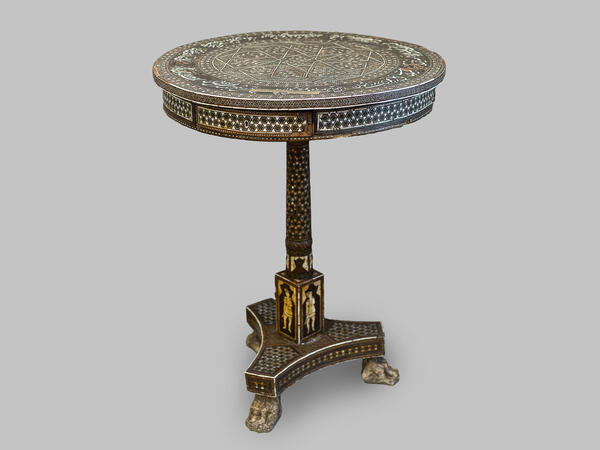The Volsk Museum of Local History houses a low, round hand-made Persian table from the 19th century. It is made of wood and inlaid with metal inserts, ivory, and mother-of-pearl plates.
Inlay is a technique for decorating the surface of an object with materials of different color and texture. Inlays include mosaics. Their pattern is formed with pieces of colored glass, stone, or marble glued to the surface. In the technique of marquetry, cheap materials are pasted over with more expensive ones, for example, a simple veneer can be decorated with ebony or mahogany inserts. Another type of inlay is intarsia, where a section of one material is inlaid into the surface of another to make them look like a single piece.
This table entered the museum’s collection in 1920 from the estate of Count Karl Nesselrode in the village of Tsarevshchina, Saratov Governorate.
The German-born Russian statesman Karl Nesselrode served as foreign minister of the Russian Empire for over 33 years, from 1816 to 1856, longer than anyone else in Russian history.
Nesselrode was of the German county family, which, upon the dissolution of the Holy Roman Empire in 1806, underwent mediatization finding themselves subordinate to the Emperor through an intermediary, a larger sovereign prince.
Nesselrode’s career began after the death of the Russian Empress Catherine II in 1796 when Emperor Pavel I granted him the post of his aide-de-camp. At the age of 20, Nesselrode was already a colonel, and in 1800, he received the court position of chamberlain. His diplomatic career began in 1801: he served as an official in the Russian mission in Berlin, The Hague, and Paris.
In 1811, Nesselrode received the rank of State Secretary under Emperor Alexander I, during the 1812 Patriotic War he was in the army, and in 1814–1815, he participated in the Congress of Vienna.
Then he was assigned to manage the Collegium of Foreign Affairs together with Count Ioannis Kapodistrias. Nesselrode was in charge of developing relations with Western countries, while Kapodistrias dealt with the East. In 1822, Kapodistrias was dismissed, and Nesselrode became the sole leader of the Collegium.
Under Emperor Nicholas I, Nesselrode retained the post of Minister of Foreign Affairs, and in 1844, he became Chancellor of the Russian Empire. He supported the rapprochement with Austria. Under his influence, Russia took part in putting down the Hungarian revolution of 1848–1849. It was because of Nesselrode’s decisions in the Crimean War of 1853–1856 that Russia found itself in international isolation. The unsuccessful outcome of the war forced him to resign in 1856.
Karl Nesselrode died in 1862 in St. Petersburg and was buried in the Smolensk Lutheran cemetery.
Inlay is a technique for decorating the surface of an object with materials of different color and texture. Inlays include mosaics. Their pattern is formed with pieces of colored glass, stone, or marble glued to the surface. In the technique of marquetry, cheap materials are pasted over with more expensive ones, for example, a simple veneer can be decorated with ebony or mahogany inserts. Another type of inlay is intarsia, where a section of one material is inlaid into the surface of another to make them look like a single piece.
This table entered the museum’s collection in 1920 from the estate of Count Karl Nesselrode in the village of Tsarevshchina, Saratov Governorate.
The German-born Russian statesman Karl Nesselrode served as foreign minister of the Russian Empire for over 33 years, from 1816 to 1856, longer than anyone else in Russian history.
Nesselrode was of the German county family, which, upon the dissolution of the Holy Roman Empire in 1806, underwent mediatization finding themselves subordinate to the Emperor through an intermediary, a larger sovereign prince.
Nesselrode’s career began after the death of the Russian Empress Catherine II in 1796 when Emperor Pavel I granted him the post of his aide-de-camp. At the age of 20, Nesselrode was already a colonel, and in 1800, he received the court position of chamberlain. His diplomatic career began in 1801: he served as an official in the Russian mission in Berlin, The Hague, and Paris.
In 1811, Nesselrode received the rank of State Secretary under Emperor Alexander I, during the 1812 Patriotic War he was in the army, and in 1814–1815, he participated in the Congress of Vienna.
Then he was assigned to manage the Collegium of Foreign Affairs together with Count Ioannis Kapodistrias. Nesselrode was in charge of developing relations with Western countries, while Kapodistrias dealt with the East. In 1822, Kapodistrias was dismissed, and Nesselrode became the sole leader of the Collegium.
Under Emperor Nicholas I, Nesselrode retained the post of Minister of Foreign Affairs, and in 1844, he became Chancellor of the Russian Empire. He supported the rapprochement with Austria. Under his influence, Russia took part in putting down the Hungarian revolution of 1848–1849. It was because of Nesselrode’s decisions in the Crimean War of 1853–1856 that Russia found itself in international isolation. The unsuccessful outcome of the war forced him to resign in 1856.
Karl Nesselrode died in 1862 in St. Petersburg and was buried in the Smolensk Lutheran cemetery.



